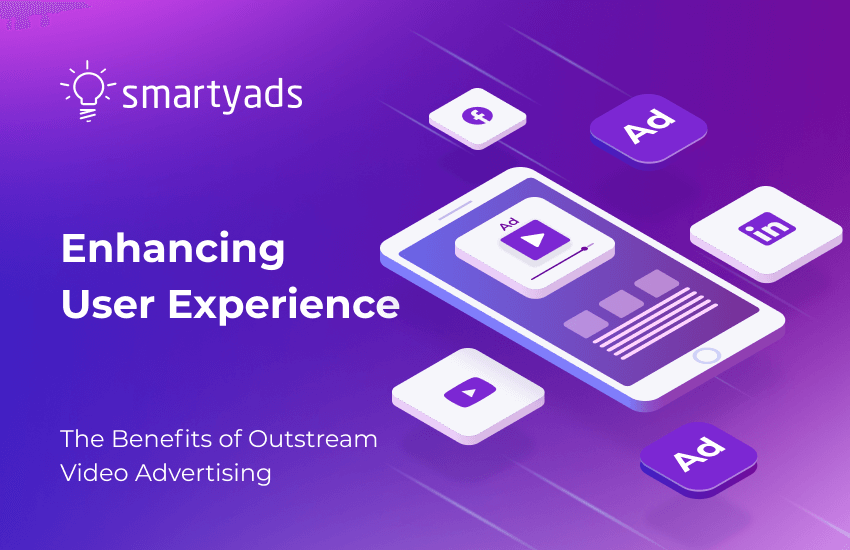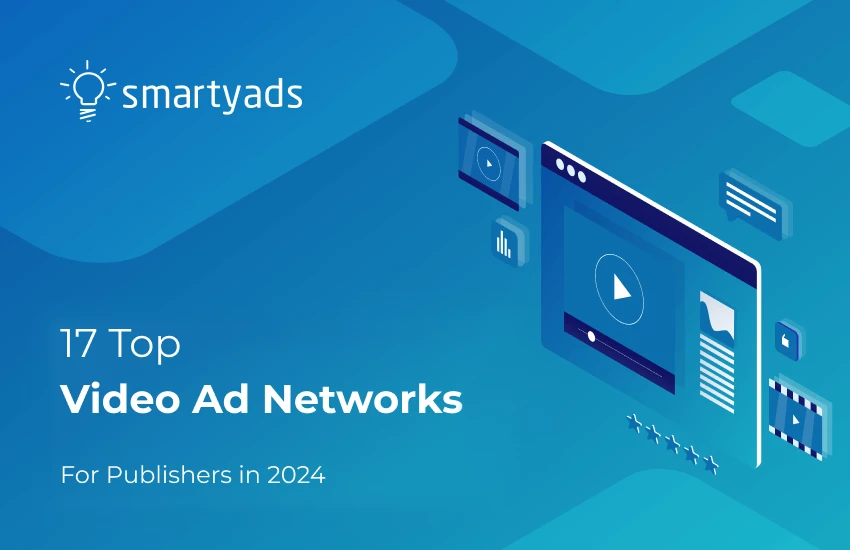Video advertising has long been part of our daily routine. It used to follow us from TV screens, and then it also moved into the online space. But over time, advertising itself has changed: from annoying commercials with repetitive jingles, it has become a form of art and communication between the brand and each individual consumer.
It's not surprising at all that 96% of marketers consider video advertising to be an integral and key part of their advertising strategy. Video ads still work and work better than many other formats. Idea Rocket data shows that posting videos on social media increases views by 48%.
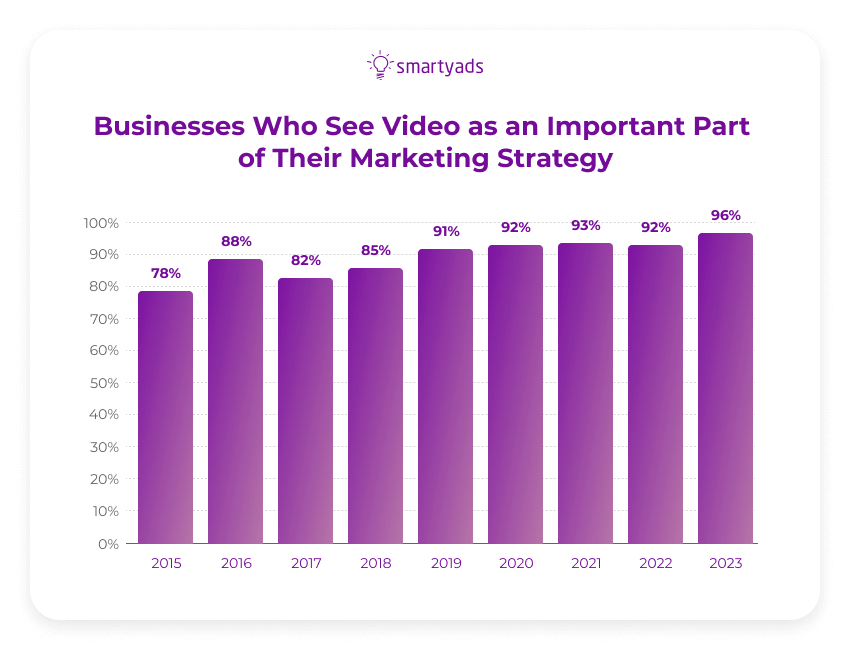
What Is an Outstream Video Ad?
Outstream video has revolutionized online advertising with its dynamic and versatile format. Unlike its counterpart, instream ads, which are confined to designated video players, outstream video thrives in unconventional settings like text-based articles and social media feeds. Its autonomous playback initiation sets it apart, seamlessly engaging users when it appears on web pages or applications. This unique feature amplifies its impact and opens up new possibilities for captivating audiences in the digital landscape.
When accomplished, outstream video ads are seamlessly integrated into the chosen digital platform, often nestled between paragraphs of text or integrated within a grid of content. These ads usually remain muted, but users are often offered the option to enable sound should they desire it.
The ads come to life automatically when they enter the user's field of view and halt playback when they are no longer visible.
This type of advertisement is often called native video ads because it is quite organically and unobtrusively embedded in the content.
The outstream video ad format brings numerous benefits to advertisers and publishers alike. It enables advertisers to reach a wider audience beyond traditional video content by strategically placing outstream ads within articles or social media feeds, where such content may not be typically found. This expanded reach allows advertisers to tap into new and diverse audiences, maximizing their brand exposure and engagement potential.
Furthermore, these ads give a non-disruptive user experience, as they do not interrupt primary content, ensuring a more seamless browsing encounter.
Publishers also profit from the expanded ad inventory and revenue generation potential that outstream video ads bring, even without their own video content.
The popularity of video ads shows that 70% of non-video marketers plan to add videos to their promotion strategy in 2023.
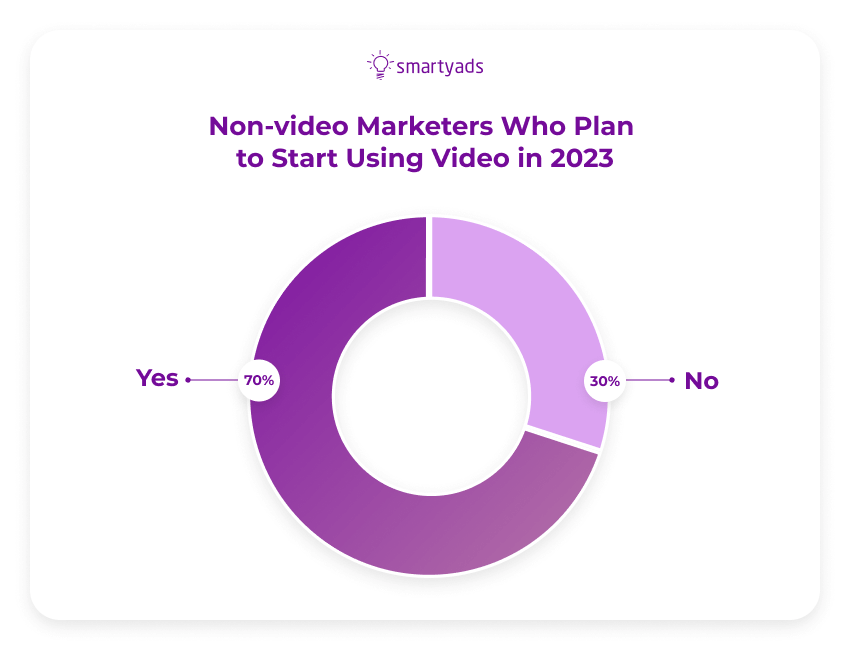
Difference between instream and outstream video ads
Of course, when considering an outstream video, we must explain how it differs from an instream ad. Instream vs. outstream video must be a serious choice in the context of your advertising strategy.
When discussing such advertising, the difference between instream advertising and in-banner advertising is not always clear.
The key difference between instream and outstream video ads lies in their video ad placements and context within the user experience.
What is an Instream Video Ad?
Instream video ads are seamlessly integrated into video content, typically appearing before (pre-roll), during (mid-roll), or after (post-roll) the main video. These ads play within a dedicated video player, commonly seen on platforms like YouTube or streaming services, and often have a predetermined duration during which they cannot be skipped.
Instream video ads are seamlessly woven into the viewing experience, as users anticipate encountering ads while consuming content. These ads offer a heightened level of immersion and enjoy greater viewability as users are actively engaged with the video player during their viewing session.
What is an Outstream Video Ad?
In contrast, outstream video advertising is specifically crafted to be showcased beyond traditional video player environments. These ads can be found within text-based articles, social media feeds, or other forms of non-video content, expanding their reach and impact.
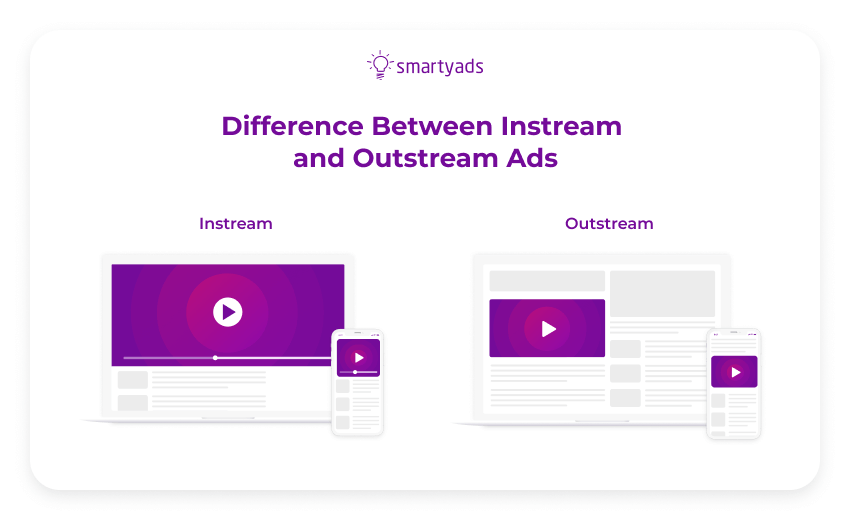
Outstream ads play automatically when they come into view on a web page or app, and they may pause or stop when they are no longer visible. These ads provide opportunities to reach a broader audience and engage users who may not be actively seeking video content. Outstream videos give a non-disruptive experience as they blend with the surrounding content and do not interrupt the primary video being watched.
Instream video ads are generally associated with longer-form video and are well-suited for delivering brand messages, product demonstrations, or storytelling experiences. They benefit from a captive audience who has chosen to watch a video.
Contrasting with their counterparts, outstream video ads offer greater versatility in terms of placement and format. These ads enable advertisers to extend their reach beyond dedicated video platforms and leverage the popularity of articles or social media feeds to captivate users with engaging video content. Such flexibility opens up new opportunities for advertisers to connect with their target audience in diverse and innovative ways.
Types of Outstream Video Ads
Within the realm of outstream video, there are distinct types that cater to specific advertising goals and user experiences. Let's delve into notable ad formats: in-page, in-banner, and in-text.
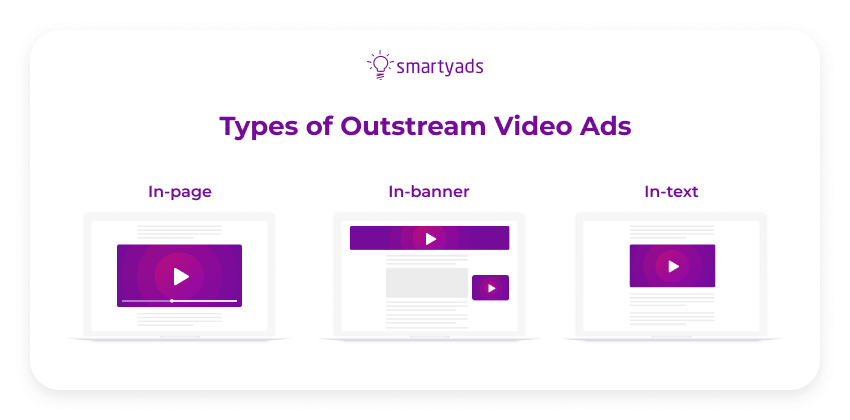
In-Page
The in-page outstream video ad format offers advertisers a compelling means to captivate audiences within the confines of a webpage. These ads seamlessly integrate into the content, positioned strategically within the page's layout.
The video ad comes to life as users scroll through the web page, sparking engagement while preserving the overall browsing experience. By embedding the video within the page's fabric, advertisers can effectively convey their brand message to users without disrupting their online journey.
In-Banner
In-banner outstream ads represent a creative fusion of static banner ads and engaging videos. When implemented, these ads inhabit a designated space within a web page, typically accompanied by visual elements or text.
As users navigate the page, the video within the banner autonomously begins playing, delivering a dynamic and attention-grabbing experience. In-banner video ads leverage the visual prominence of traditional display banners while harnessing the power of video to convey messages in a more captivating and memorable manner.
In-Text
In-text outstream video ads revolutionize the way advertisers deliver video ads by embedding them directly within written articles or textual content. These ads seamlessly merge within the text, often appearing between paragraphs or at natural breakpoints.
As users engage with the article, the video ad springs to life, enriching the reading experience with multimedia storytelling. By seamlessly integrating video within the written narrative, in-text outstream ads offer an immersive and engaging encounter, captivating users while they consume textual content.
Each outstream video ad type serves as a strategic tool for advertisers, empowering them to tailor their campaigns to specific contexts and maximize audience engagement.
Benefits of Outstream Video Ads for Publishers
According to the eMarketer report, video ad spending continues to grow as a share of total programmatic advertising. In 2022, video accounted for over half of all programmatic media ad spending for the first time.
In 2023, the amount of money U.S. advertisers spend on programmatic digital video will exceed that of linear television advertising. In the next few years, nearly 9 out of 10 dollars invested in digital video advertising will be in programmatic media.
This means that the outstream video advertising market will only grow and evolve in the coming years, so it's worth exploring its benefits.
Increased ad inventory
Outstream video ads allow publishers to monetize their content more effectively by expanding their ad inventory. Since these ads are not limited to specific video players, publishers can place them within various sections of their web pages, thereby increasing the number of available ad placements.
Improved user experience
Outstream video ads enhance the user experience by being less intrusive than traditional video ads interrupting the content flow. These ads typically autoplay when they appear on the screen and are often accompanied by sound only if the user engages with them. As a result, they provide a non-disruptive and seamless ad experience.
Increased revenue potential
Outstream video ads enable publishers to tap into new revenue streams. By leveraging the expanded ad inventory and providing engaging video ad experiences, publishers can attract more advertisers and command higher ad rates, increasing their overall revenue potential.
Broadened reach and engagement
Outstream video ads can reach a wider audience as they are not restricted to video-specific placements. Publishers can embed these ads within articles, blog posts, or other textual content, allowing them to engage users who might not typically consume video content or engage with video players.
Flexibility and scalability
Outstream video ads offer flexibility in terms of ad placement and format. Publishers have the freedom to choose where and how these ads are displayed, making them adaptable to different screen sizes and devices. Additionally, the scalability of video ads allows publishers to cater to different content types and adapt their ad strategies accordingly.
The disadvantages of outstream video advertising
In the ever-evolving digital advertising landscape, outstream video ads have emerged as a popular alternative to traditional instream placements. While they offer the advantage of reaching audiences beyond dedicated video platforms, this innovative advertising format is not without its drawbacks.
Let's explore the disadvantages of outstream video ads, including concerns over user experience and viewability.
User Experience: Intrusion and Disruption
Outstream video advertising, when poorly implemented, can disrupt the seamless browsing experience users expect. With the potential to be intrusive and autoplay without user consent, these ads can interrupt reading or browsing activities, leading to frustration and a negative perception of the ad itself and the hosting website.
The desire to engage users must be carefully balanced with respect for their browsing intentions.
Viewability Challenges: Missed Opportunities
One of the key metrics advertisers value is ad viewability — the likelihood that users actually see an ad. Unfortunately, outstream video ads often suffer from lower viewability rates compared to their instream counterparts.
Embedded within non-video content, these ads risk being scrolled past before they have a chance to play. As a result, viewability metrics can plummet, undermining the ad's reach and effectiveness.
Engagement Limitations: Attention Woes
Outstream video ads face an inherent challenge when it comes to engaging users who are not actively seeking video content. Without the intentional user mindset typically associated with video platforms, the likelihood of capturing and retaining users' attention diminishes. Consequently, the effectiveness of video ads in generating brand awareness or driving conversions may be compromised.
Contextual Relevance
Another disadvantage of outstream video ads lies in the realm of contextual relevance. Placed within non-video environments, these ads struggle to align with the interests and preferences of their target audience.
The absence of a direct tie-in to video content can result in placements that feel out of place or irrelevant, weakening the impact of the ad and diminishing its resonance with viewers.
Ad Blocking
The rise of ad-blockers and browser extensions poses yet another challenge for out-stream video ads. Users who employ such tools can effectively render these ads invisible, significantly limiting their reach and potential effectiveness. Advertisers must confront the reality that some of their target audience may be impervious to video ads due to these protective measures.
Bottom Line
No brand or marketing strategy today is without video advertising. Outstream video allows you to take video advertising beyond players and video hostings and distribute it with the same targeting as banner ads. It's a great advertising tool for advertisers and a great opportunity to monetize the platform for publishers.
If you want to add outstream video to your marketing plan as well, contact us!
